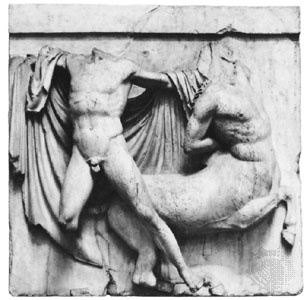Elgin Marbles
Greek sculpture
 collection of ancient Greek sculptures and architectural details in the British Museum, London, where they are now called the Parthenon Sculptures. The objects were removed from the Parthenon at Athens and from other ancient buildings and shipped to England by arrangement of Thomas Bruce, 7th Lord Elgin (Elgin, Thomas Bruce, 7th earl of, 11th Earl Of Kincardine), who was British ambassador to the Ottoman Empire (1799–1803). The removal created a storm of controversy that exemplified questions about the ownership of cultural artifacts and the return of antiquities to their places of origin.
collection of ancient Greek sculptures and architectural details in the British Museum, London, where they are now called the Parthenon Sculptures. The objects were removed from the Parthenon at Athens and from other ancient buildings and shipped to England by arrangement of Thomas Bruce, 7th Lord Elgin (Elgin, Thomas Bruce, 7th earl of, 11th Earl Of Kincardine), who was British ambassador to the Ottoman Empire (1799–1803). The removal created a storm of controversy that exemplified questions about the ownership of cultural artifacts and the return of antiquities to their places of origin.Elgin was a lover of art and antiquities. By his own account, he was concerned about damage being done to important artworks in the temples of Greece, then under Ottoman sway. Fearing that they would eventually be destroyed because of Turkish indifference, he asked permission of the Sublime Porte to have artists measure, sketch, and copy important pieces of sculpture and architectural detail for posterity. At length the request was granted—along with the authority “to take away any pieces of stone with old inscriptions or figures thereon.”
 Elgin then began selecting a vast store of the treasures for shipment to England. Among these were friezes (frieze), pediment sculptures (pediment), and fragmented statues from the cella (interior chamber) walls of the Parthenon; the northeast column, an anta capital, blocks of wall crown (crown molding), including architrave and cornice, and a caryatid from the Erechtheum (a temple of Athena); and various other antiquities from Athens, Attica, and other sites.
Elgin then began selecting a vast store of the treasures for shipment to England. Among these were friezes (frieze), pediment sculptures (pediment), and fragmented statues from the cella (interior chamber) walls of the Parthenon; the northeast column, an anta capital, blocks of wall crown (crown molding), including architrave and cornice, and a caryatid from the Erechtheum (a temple of Athena); and various other antiquities from Athens, Attica, and other sites.A series of shipments took the treasures to England in 1802–12 with but one mishap—HMS Mentor sank in a storm off the Greek isle of Cythera in 1804, but the entire cargo was recovered. Elgin left the embassy in 1803 and arrived in England in 1806. The collection remained private for the next 10 years.
An outcry arose over the affair, and Elgin was assailed for rapacity, vandalism, and dishonesty in hauling the Grecian treasures to London. Lord Byron (Byron, George Gordon Byron, 6th Baron) and many others attacked Elgin's actions in print. A select committee of Parliament was established to examine the sculpture and the possibility of acquiring it for Britain. In 1810 Elgin published a defense of his actions that silenced most of his detractors. The final shipment of the Elgin Marbles reached London in 1812, and in 1816 the entire collection was acquired from Elgin by the crown for the sum of £35,000, about half of Elgin's costs.
The Greek government has frequently demanded the return of the marbles, but the British Museum—claiming among other reasons that it has saved the marbles from certain damage and deterioration—has not acceded, and the issue remains controversial. The New Acropolis Museum in Athens, which is adjacent to the ancient site, was completed in 2008; a large space in the museum is devoted to the Parthenon, and the pieces removed by Elgin are represented by veiled plaster casts.
- parable fable, and allegory
- parabola
- parabolic equation
- paraboloid
- paracanthopterygian
- Paracas
- Paracel Islands
- Paracelsus
- parachute
- parade
- Paradip
- paradise
- paradox
- paradoxes of Zeno
- Paradoxides
- Paradoxides Series
- Paradzhanov, Sergey Yosifovich
- paraffin hydrocarbon
- paraffin wax
- Parafusulina
- paragenesis
- paragliding
- paragonimiasis
- paragonite
- Paraguaná Peninsula